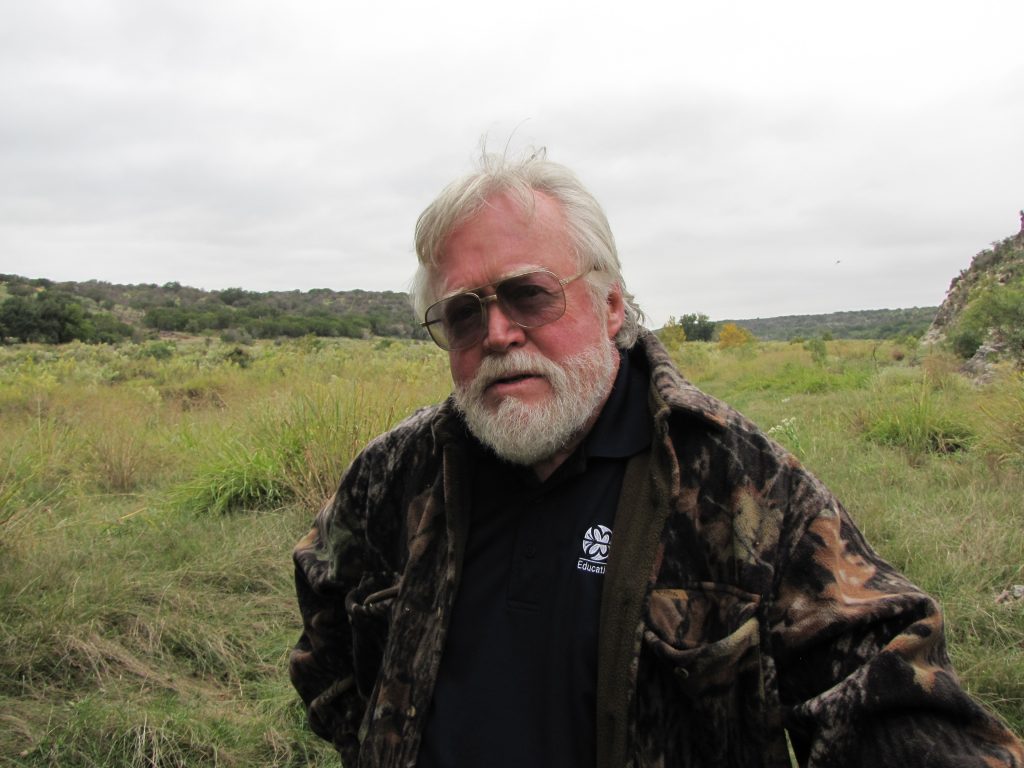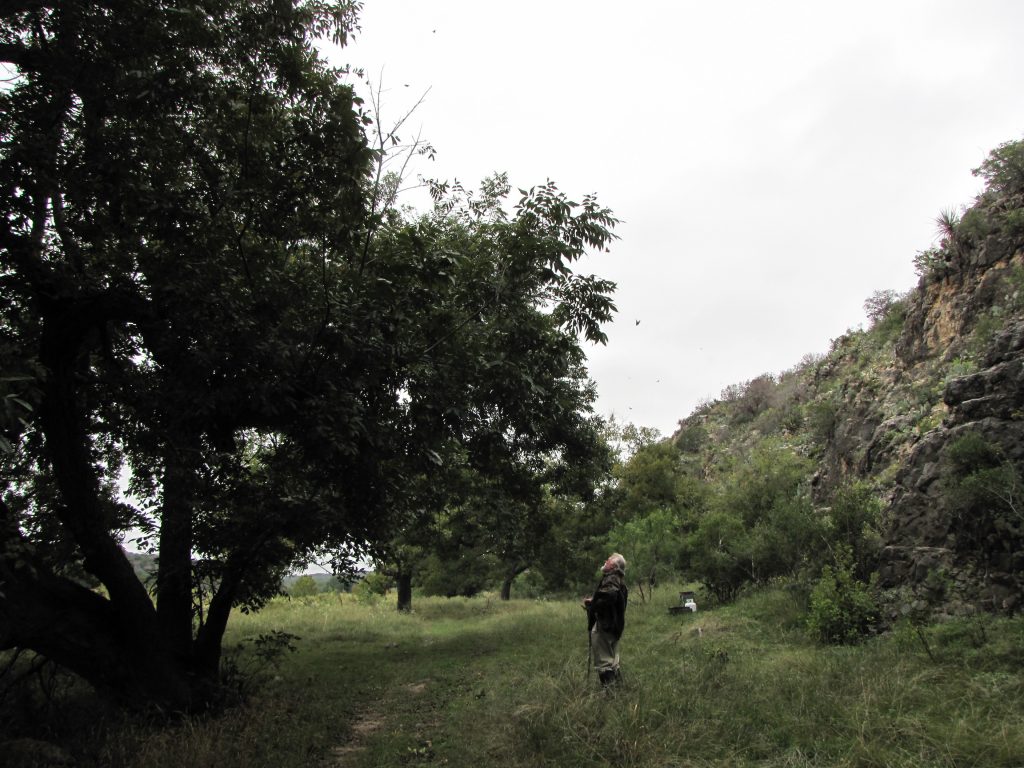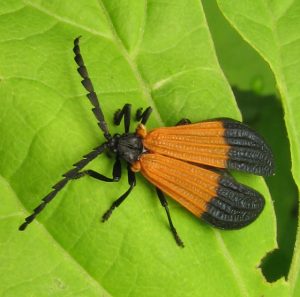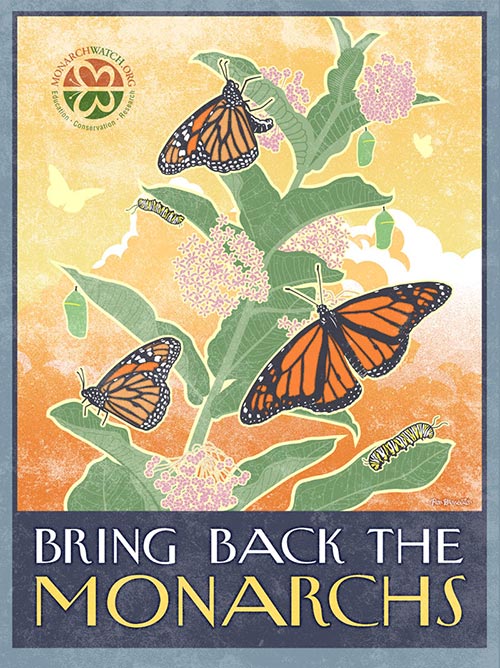With overcast skies and falling temperatures last Saturday, Dr. Chip Taylor and I sneaked out of the Native Plant Society of Texas annual conference in Kerrville to chase Monarch butterflies on the Llano River. Dr. Taylor had made a quick trip to Texas from the University of Kansas, Lawrence, to address more than 280 NPSOT members on what we can do about the threats to native milkweeds and the Monarch butterfly migration.

Monarch Watch founder Dr. Chip Taylor on the Llano River in the Texas Hill Country
His prescription: cultivate seeds, plugs and plants of more native milkweed species through a Texas version of Bring Back the Monarchs, an innovative prairie restoration program that NPSOT is importing from Kansas. Why the Texas focus? “It’s the most important state. Spring conditions in Texas determine Monarchs numbers,” he told the NPSOT audience.
In NPSOT’s joint venture with Monarch Watch, local volunteers like Texas Master Naturalist Cathy Downs and Monarch Watch Conservation Specialist Skip “Kip” Kiphart will organize others to help collect native milkweed seeds and share them with approved growers for cultivation and distribution. “Last year we had a small version of this program,” said Bill Hopkins, a NPSOT volunteer, adding that the program is in the formative and fundraising stages.
Taylor’s 50-minute talk followed a presentation by hydrogeologist William “Feather” Wilson, President of Strata Geological Services, detailing the serious water challenges our region faces as the Texas population booms and drought persists. These two sobering talks on climate change and environmental challenges were about as much as I could take on a Saturday morning after only one cup of coffee. I was ready for an escape.
“Wanna go to the ranch?” I asked Dr. Taylor. “Let’s go,” he said.
Taylor and I have spoken, emailed and corresponded many times over the past five years, but this was my first chance to meet one of my Monarch butterfly heroes: the founder of Monarch Watch. Anyone who follows the Monarch migration or tags Monarchs has heard about and seen photos of the feisty 75-year-old, whose signature scruffy white beard and blazing blue eyes call Santa Claus to mind.
The prospect of tagging Monarchs with Dr. Taylor presented a slightly stressful situation for me. Monarch tagging has a lot in common with fishing in that you just never know if they’ll show up. And even if the flighty insects make an appearance, they might not be accessible for netting and tagging. My hope was that Dr. Taylor, having traveled so far, would have a satisfying Monarch butterfly experience.
The cool weather, a north wind and the timing of our spontaneous outing in the middle of our peak migration period gave me hope that we would see Monarch butterflies. A text message from my friend and Monarch scout Terry Pittsford in Menard–“Monarchs flying all over Mason County!”–stoked my cautious optimism.

A small roost of about 200 Monarchs gathered in a pecan tree on the Llano River to the sage delight of Dr. Taylor.
The one-hour drive from Kerrville to our family’s Llano River ranch was a revelation for Taylor. He said the outing gave him a greater understanding of our precious Texas Hill Country. That some Texas highways allow speed limits of 80-miles-per-hour caught him by surprise. As he followed my decade-old Toyota Four-runner in a brand new Highlander rental, he seemed slightly flummoxed at the quick pace we were tracking on the winding Hill Country back roads. “You always drive that fast?” he asked. “Dr. Taylor, you’re not in Kansas anymore,” I reminded him.
At our gate just yards from the Kimble-Mason county line, the outside temperature read 58 degrees. “I’m not seeing any,” I said, in an attempt at expectation management. But of course, wise Dr. Taylor didn’t need his expectations managed. He knows well the elusive and unpredictable tendencies of Monarch butterflies.
Following a tricky crossing of the Llano’s slippery limestone bed, Taylor and I walked the pecan grove along the riverbank where Monarchs typically roost each fall en route to Mexico. Around 4:30 PM, we noticed about a dozen Monarchs wafting high among the pecan branches. Then Taylor identified a cluster of about 200 gathered in two high limbs. “Here they are,” he said matter-of-factly.
As a north wind blew in, more Monarchs took up the roost. Taylor couldn’t help but crack a wide grin.

Dr. Chip Taylor takes in the scene of the Llano River bottom where pecan trees invite annual roosts of the migrating insects.
“It’s always fun to see Monarchs in a new area,” he said later, adding that he’s only tagged a few hundred Monarchs in his time. “I usually leave that to others to have all the fun. My job is to organize and harvest the data.”
Always the curious student, Taylor took in the scene, remarking on our karst limestone formations, marveling at the Llano, the “last wild river” in Texas, quizzing me on native plants, and observing a fresh hatch of Lycid beetles–first mistaken for a moth—on a nearby bloom. We tagged only three butterflies in our 45-minute sojourn. The roosting bunch was out of reach.
Dr. Orley “Chip” Taylor is a walking case study in adaptation. With his hefty Monarch butterfly reputation, one would assume that butterflies have been his life’s work. Not so. He didn’t start Monarch Watch until 1992.

Dr. Taylor was fascinated with a fresh hatch of Lycid beetles, and used the occasion to explain Muellerian mimicry. –photo via www.pollinators.blogspot.com
Working toward his PhD in zoology at the University of Connecticut, Taylor studied insect ecology and population biology extensively. He realized as he finished his dissertation in 1969 that he was seriously allergic to the orange and yellow Sulphur butterflies that were the subject of his dissertation. Such reactions are not uncommon for scientists, Taylor said. By 1972, ”I grew seriously asthmatic, and was having to take prednisone every day,” he recalled. “I knew I had to stop.” And by 1973, he did.
He switched his scientific focus to honey bees in 1974. More than two decades later, he determined that to secure funds to continue studying the creatures, he would have to move into molecular biology, a field that didn’t interest him. That’s when he turned to Monarchs. “I’ve morphed twice,” he said.
Taylor founded Monarch Watch when he was 55 years old–an age when many of us consider retirement. The organization has done more to enlighten the world about the unique charms and challenges of the Monarch butterfly migration than any other, and with the recent release of the film, “Flight of the Butterflies” Taylor senses a tipping point in public awareness. Forty-five percent of the profits from the IMAX movie will be channeled to Monarch conservation, he told NPSOT members during his talk.
The organization, like its founder, has adapted its focus. It began with an exclusive focus on Danaus plexippus, but has evolved to become a conservation organization—an inevitable outcome of embracing the life cycle of the Monarch butterfly. That’s fine with Taylor, who sees the Monarch’s plight as a siege on all pollinators and the ecosystems that sustain them–and us. “Our human welfare is being negatively affected,” he said, adding that in some locations in China, ecosystems are so degraded that apple trees must be pollinated by hand.
Taylor’s NPSOT presentation focused mostly on the myriad threats to the Monarch migration, but he ended the serious overview on an upbeat note. Recently he rallied his resources to help turn a former chemical recycling facility and Superfund site into a living pollinator laboratory and demonstration garden. Taylor designed the site himself, to include butterfly, Monarch, honeybee, and pollinator gardens at the former CCI chemical recycling plant in Olathe, Kansas. More than 100 volunteers joined Taylor and others last month to install the plants that will comprise these gardens. “We planted 1,600 plants in 55 minutes,” Taylor said proudly, adding that all were native to eastern Kansas.
When he’s not traveling as a Monarch butterfly champion, Taylor still teaches at the University of Kansas at Lawrence. “I teach one course: the World of 2040,” he said. “It’s a seminar in which students have to research what the world will be like in 27 years and it scares the bejeezus out of them.”
He still grades papers, leads several professional development classes, and spends time with his wife of 49 years, Toni, now retired after many years working in the library system at the University. His two grown daughters obviously make him proud–Robin works as a consumer reporter for a television station in Pittsburgh and Wendy pursues a career in public health. Between three grandchildren, a beloved Golden Retriever, Chugaah, who he named after the Chugach Mountains in Alaska where he manages an annual fishing trip, life is busy.
We raced back to Taylor’s rental so he can leave the ranch and return to Kerrville in time for a dinner, and before deer crowd the roads at dusk. “Ever ever think about retirement?” I asked. “I’ve thought about it,” he said. “But I just have too much to do.”


Dr. Taylor’s dedication and passion is amazing. We need more people like Chip in the world!
“Taylor, who sees the Monarch’s plight as a siege on all pollinators and the ecosystems that sustain them–and us. ” – this is definitely the true message. So sad that people do not realize it.
PS I have a small Monarch habitat in my backyard, which includes Gregg’s Mistflower and Tropical Milkweed. I watched a female Monarch lay eggs, I’ve seen cats in the first instar, but they disappear. I’m thinking Wasp are the culprit. Any advice? Thanks!
You can save the cats by bringing them into a safe place to continue eating milkweed and make their chrysalises. Monarch Watch sells a wonderful condo (I have two) that you can put on a screened-in porch or other location where the cats are away from predators. Be sure to get tags from Monarch Watch and tag them before you release them in September and October!
Where can interested butterfly-lovers help with tagging?
I’d really like to learn how to do this!
Thank God for Chip Taylor. And don’t forget that we have to plant lots of milkweed to counteract the loss of this vital plant. We’re losing it through development, roadside maintenance mowing, farming, and herbicides. So plant milkweed. Wild Ones, the national not for profit organization (http://wildones.org), has partnered with Monarch Joint Venture, and Monarch Watch’s “Bring back the Monarch” campaign to help with this conservation effort. Local Wild Ones chapters are collecting Milkweed seed now will be distributing Milkweed plants this spring. Plant Milkweed and other native nectar plants. We can turn this trend around.
All the “milkweed restoration” projects to date have been very localized, very small scale projects that add mathematically insignificant quantities of milkweed to the landscape relative to the amount of that gets destroyed in by sprawl and more intensive weed control practices on farmland and roadsides. So perhaps for every 1 milkweed plant that gets planted somewhere around 1,000 or 10,000 likely get destroyed. Thus the restoration projects won’t make a mathematically significant dent in the pace of monarch population decline. So few milkweeds have been planted on such a small scale that no one to date has even posted photos or videos large patches of milkweed that were successfully established along roadsides, railway lines, in pastures or on cropland.
Wild Ones (http://wildones.org) has partnered with Monarch Joint Venture and MonarchWatch’s Bring Back the Monarch campaign to help increase the Milkweed populations. This is a national campaign that will roll out in 2013 and Wild Ones’ chapters are currently busy collecting milkweed seeds and working with local growers in support of this effort.
“Never doubt that a small group of thoughtful, committed citizens can change the world. Indeed, it is the only thing that ever has. – Margaret Mead
Bravo! We’re hoping to get on the stick here in Texas, too, with the Native Plant Society and Monarch Watch’s Bring Back the Monarchs campaign.
MM
That’s, true for now, Paul. So what do you suggest and what is your point? Do nothing?
MM